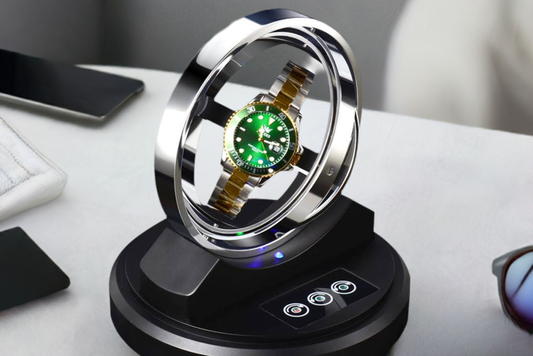Discover the art of winding mechanical watches and master the techniques that ensure your timepiece stays in top condition. From hand-wound to automatic watches, learn the dos and don'ts, frequency, and the right way to wind, avoiding damage and preserving your watch's longevity.
The Basics of Winding a Mechanical Watch
Hand-Wound Watches 101
Correct Winding Direction: Always wind your mechanical watch clockwise until you feel resistance, ensuring not to overwind. This is crucial to prevent damaging the watch's internal mechanisms.
Starting Point: Ensure the crown is in the winding position, closest to the case, before you begin winding. This position allows for a smooth and efficient winding process.
Credit: YouTube Channel - Timed Square
Automatic Watches Demystified
Self-Winding Mechanics: Automatic watches, also known as self-winding watches, use a rotor that winds the watch as the wearer moves their arm. This rotor is connected to the watch's mainspring, which powers the watch's movement.
Manual Winding for Automatics: Even automatic watches may require manual winding occasionally, especially if they have not been worn for an extended period. This is because the rotor may not generate enough power to keep the watch running. Manual winding ensures the watch remains accurate and functional.
How Often to Wind a Mechanical Watch: The Frequency Dilemma
Mechanical watches require regular winding to maintain their accuracy and functionality. The frequency of winding depends on various factors, including the type of watch, its power reserve, and the wearer's lifestyle.
Daily Winding: The Benefits and Why It's Recommended
Daily winding is recommended for most mechanical watches, especially those with a lower power reserve (typically 36-40 hours). Winding your watch daily ensures that the mainspring remains fully tensioned, which is essential for maintaining the watch's accuracy and preventing damage to the mechanism. Daily winding also helps to:
- Prevent Over-Winding: Avoiding over-winding, which can put excessive stress on the gears and mainspring, potentially leading to damage or breakage.
- Maintain Accuracy: Keeping the watch accurate by ensuring a consistent power supply to the escapement, which regulates the time.
- Reduce Wear and Tear: Minimizing the wear on the gears and other moving parts by maintaining a consistent power supply.
Letting It Stop: The Potential Impact on Watch Mechanics and When It's Acceptable
While daily winding is recommended, it's not always possible or necessary. Letting a mechanical watch stop can have some consequences, including:
- Reduced Accuracy: The watch may lose or gain time, affecting its accuracy.
- Increased Wear and Tear: The gears and other moving parts may experience increased wear due to the sudden stop and subsequent restart.
- Potential Damage: In extreme cases, letting a watch stop for extended periods can cause damage to the mechanism, especially if the watch has a complex movement or is not designed to withstand prolonged periods of inactivity.
However, there are situations where letting a mechanical watch stop is acceptable or even necessary:
- Storage: If the watch is to be stored for an extended period, it's recommended to wind it down to prevent damage from over-winding or to reduce the risk of damage from a sudden stop.
- Maintenance: During maintenance or repair, the watch may need to be stopped to allow for the necessary work to be performed.
- Power Reserve: Some watches have a longer power reserve (typically 7-10 days or more), making daily winding less critical.
Winding Techniques That Preserve Your Watch
The Gentle Touch
Index Finger and Thumb Method: The preferred method for winding a watch involves using the index finger and thumb to gently turn the crown. This technique allows for even winding and helps prevent overwinding, which can damage the watch's mechanism. Place the crown between your index finger and thumb, with your index finger on top and your thumb on the bottom. Gently turn the crown clockwise until you feel resistance, indicating the watch is fully wound.
Avoiding Overwinding: Recognizing the hard stop and stopping before damage occurs is crucial when winding a watch. Overwinding can put excessive strain on the watch's gears and springs, leading to premature wear and potentially causing damage. Wind your watch in a gentle and controlled manner, stopping as soon as you feel resistance. Wind your watch regularly to prevent the mainspring from becoming too tightly wound, which can also cause damage.
Special Considerations for Different Watch Types
Vintage Watches
Delicate Mechanics: When it comes to vintage watches, special care is necessary to preserve their delicate mechanics. Winding a vintage watch requires a gentle touch and attention to detail to avoid damaging the intricate mechanisms. Here are some tips:
- Handle with care: Vintage watches are often fragile and require careful handling to avoid damaging their delicate components. Always handle them with clean, dry hands, and avoid exposing them to extreme temperatures or humidity.
- Use the correct winding technique: Vintage watches often have specific winding mechanisms that require a gentle, consistent motion to avoid damaging the gears or springs. Research the specific winding technique recommended for your vintage watch model to ensure you're winding it correctly.
- Avoid over-winding: Vintage watches can be prone to over-winding, which can cause damage to the mainspring or other components. Stop winding when you feel resistance or when the watch is fully wound.
- Store properly: When not in use, store your vintage watch in a cool, dry place, away from direct sunlight and moisture. Consider using a watch winder or storage box specifically designed for vintage watches to keep them safe and protected.
Modern Innovations
Anti-Shock Systems: Modern watches often feature anti-shock systems designed to protect the watch's delicate mechanisms from impact and vibration. These systems can affect how you wind and care for your watch:
- Shock-resistant winding: Some modern watches feature shock-resistant winding mechanisms that can withstand rough handling. However, it's still important to wind your watch gently and consistently to avoid damaging the gears or springs.
- Impact protection: Anti-shock systems can protect your watch from impact, but it's still important to handle your watch with care. Avoid dropping your watch or subjecting it to extreme impact, as this can still cause damage.
- Regular maintenance: Regular maintenance, including cleaning and lubricating the watch's mechanisms, is still necessary to keep your modern watch running smoothly. Consult your watch's user manual or contact a professional watchmaker for guidance on maintenance and repair.
Winding vs. Shaking: Why Winding is Preferred Over Shaking to Power Automatic Watches
Automatic watches are designed to harness kinetic energy from the wearer's movements to power the watch's mechanism. While both winding and shaking can generate power for these watches, winding is generally preferred over shaking for several reasons:
Efficiency and Consistency: Winding is a more efficient and consistent way to power an automatic watch. When you wind an automatic watch, you are directly turning the mainspring, which stores energy that is then released to power the watch's mechanism. Shaking, on the other hand, relies on the watch's rotor to convert the wearer's movements into energy, which can be less efficient and less consistent.
Reduced Wear and Tear: Winding an automatic watch reduces wear and tear on the watch's mechanism compared to shaking. When you shake an automatic watch, the rotor and other moving parts are subjected to more stress and friction, which can lead to increased wear and tear over time. Winding involves a more controlled and deliberate movement that puts less stress on the watch's components.
Better Power Reserve Management: Winding allows for better power reserve management. When you wind an automatic watch, you can control how much energy is stored in the mainspring, enabling you to manage the watch's power reserve more effectively. Shaking can result in an unpredictable power reserve, as the amount of energy generated depends on the wearer's movements, which can vary greatly.
Starting a Stopped Watch: The Right Way to Revive a Dormant Mechanical Watch
If your mechanical watch has stopped, there are a few steps you can take to revive it:
- Check the Power Reserve: First, check the power reserve of your watch. If it has stopped due to a depleted power reserve, you may need to wind it. If the power reserve is not the issue, proceed to the next step.
- Wind the Watch: Wind your watch according to the manufacturer's instructions. This typically involves turning the crown clockwise until you feel resistance. Be careful not to overwind, as this can damage the watch's mechanism.
- Check for Obstructions: Check the watch for any obstructions that may be preventing it from running. This could include dirt, dust, or other debris that may have accumulated on the watch's gears or other moving parts.
- Consult a Professional: If your watch is still not running after winding and checking for obstructions, it may be necessary to consult a professional watchmaker. They can diagnose any underlying issues and perform the necessary repairs to get your watch running again.
Storage and Maintenance: Tips to Keep Your Watch Wound and in Prime Condition
Proper storage and maintenance are crucial to keep your wound watch in excellent condition. Here are some valuable tips:
- Store in a Cool, Dry Place: Avoid storing your watch in areas with high humidity or extreme temperatures, as this can affect the watch's accuracy and longevity. A temperature range of 15°C to 30°C (59°F to 86°F) is ideal.
- Keep Away from Magnetic Fields: Magnetic fields can interfere with your watch's accuracy. Store your watch away from electronic devices, such as computers, televisions, and speakers.
- Use a Watch Winder: A watch winder is a device that rotates your watch to keep it wound. This is especially useful for automatic watches that rely on movement to wind. You can find watch winders from brands like Orbita ($129) and Wolf Designs ($199).
- Wind Your Watch Regularly: For manual-wind watches, wind them daily to ensure they remain accurate. For automatic watches, wear them regularly or use a watch winder to keep them wound.
- Clean Your Watch: Regularly clean your watch with a soft cloth to remove dirt and oils from your skin. Avoid using harsh chemicals or abrasive materials that can damage the watch's finish.
Servicing: How Often and Why Professional Maintenance is Crucial
Regular servicing is essential to maintain your watch's accuracy and extend its lifespan. Here's why and how often you should service your watch:
- Service Intervals: Most watch manufacturers recommend servicing every 3 to 5 years, depending on the watch's usage and type. For example, Rolex recommends servicing every 5 years, while Omega suggests every 3 to 5 years.
- Why Service is Necessary: Servicing involves cleaning and lubricating the watch's movement, replacing worn-out parts, and adjusting the watch's accuracy. This prevents damage from worn-out parts, ensures accurate timekeeping, and maintains the watch's water resistance.
- Authorized Dealers vs. Independent Watchmakers: It's recommended to service your watch through an authorized dealer, as they have the necessary expertise and genuine parts. However, independent watchmakers can also provide quality service at a lower cost.
- Cost of Servicing: The cost of servicing varies depending on the watch brand and type. On average, servicing can cost between $200 to $1,000. For example, servicing a Rolex can cost around $500 to $800, while servicing an Omega can cost around $300 to $600.
- DIY Maintenance: While some watch enthusiasts may attempt DIY maintenance, it's not recommended, as it can void the warranty and cause damage to the watch. Leave servicing to professional watchmakers or authorized dealers to ensure your watch remains in prime condition.
Conclusion
Mastering the art of winding your mechanical watch is essential to ensure your timepiece remains a timeless treasure. From the gentle winding technique to understanding the nuances of different watch types, this comprehensive guide equips you with the knowledge to cherish your watch for years to come. By following the proper winding techniques, storage, and maintenance tips, and servicing your watch regularly, you can preserve your watch's accuracy, functionality, and longevity. Share your thoughts and experiences in the comments below, and don't forget to share this guide with fellow watch enthusiasts!
FAQ
How do I know if my watch is fully wound?
When winding your watch, you will feel a slight resistance when the mainspring is fully wound. Stop winding as soon as you feel this resistance to avoid overwinding and potentially damaging your watch. Most watches will also have a power reserve indicator that shows how much energy is stored in the mainspring.
Can I overwind my watch?
Yes, it is possible to overwind your watch. Overwinding can put excessive strain on the watch's gears and springs, leading to premature wear and potentially causing damage. To avoid overwinding, wind your watch gently and stop as soon as you feel resistance.
How long can I expect my mechanical watch to run after fully winding it?
The running time of a fully wound mechanical watch depends on its power reserve. Most modern mechanical watches have a power reserve of 36 to 72 hours, while some high-end watches can run for up to 10 days or more. Consult your watch's user manual or specifications to determine its specific power reserve.
Is it necessary to wind my automatic watch?
While automatic watches are designed to wind themselves through the wearer's movements, they may still require occasional manual winding, especially if they have not been worn for an extended period. If your automatic watch has stopped, give it a few manual winds to get it started, then wear it regularly or use a watch winder to keep it running.
Can I wind my watch while it's on my wrist?
It is generally not recommended to wind your watch while wearing it on your wrist. Winding your watch while it's on your wrist can put unnecessary strain on the crown and the watch's internal mechanisms. Instead, take the watch off your wrist, hold it in your hands, and wind it using the proper technique.




